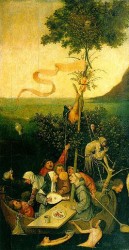
Boczkowska 1971
“The Lunar Symbolism of The Ship of Fools by Hieronymus Bosch” (A. Boczkowska) 1971
[in: Oud Holland, vol. LXXXVI (1971), pp. 47-69]
[Also mentioned in Gibson 1983: 113 (E233)]
The Ship of Fools (Paris, Louvre) represents first en foremost a ‘lunar boat’ and the crew are ‘children of the moon’. The boat has a tree for a mast: the tree is an attribute of the moon and signifies the moon’s influence over the plant world. The tree is also a symbol of change and of the passing of time, of birth, of life and of approaching death. In Bosch’s painting a flag with the moon hangs from a tree of life: an archetypal moon tree linking life and death with the idea of change (concerning the idea of death the author refers to the ‘skull’ between the leaves of the tree, whereas actually it is a little owl we see there).
The people in Bosch’s ship have a phlegmatic temperament. The phlegmatic character is namely influenced by the moon. People standing in the water or near the sea are often found in in fifteenth- and sixteenth-century illustrations of the phlegmatic temperament. In Bosch’s painting we see a fish hanging from a branch (fish = lunar attribute) and two people are swimming next to the boat. Striking is further the large number of pitchers and pots: the ‘children of the moon’ were traditionally obsessed by eating and drinking and it was believed that the moon controls the digestive system, the stomach and stomach ailments.
Other characteristics of the phlegmatic character are: irritation (the woman hitting a man with a pitcher), a pale ànd flushed complexion (the nun and the monk look pale, the others’ faces are ruddy) and a fondness for music. The protagonist of the Ship of Fools is the jester: in the fifteenth and sixteenth century a symbol of the wandering mind, subject to the influence of the moon as the planet that provokes lunacy.
By means of the symbolism centering around the ideas of ‘moon’ and ‘phlegmatic character’ Boczkowska thinks she can also explain the Allegory of Gluttony (Yale University), the Merrymakers in a Mussel Shell engraving (published by Hieronymus Cock), the Concert in an Egg (Lille) and three Bruegel drawings (Gula, Acedia and Invidia). The Bosch works discussed in this astrologically oriented article are said to express a pessimistic image of sinful humanity, without will and intellect, controlled by the moon.
[explicit]